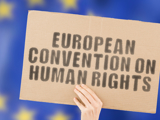What is the Magna Carta?
Most of us have heard of the Magna Carta but what exactly is it? And why do people in the UK, notably politicians, often refer to this medieval document?
Magna Carta, meaning “The Great Charter”, came about in 1215, during King John’s reign. To give you a bit of context, this is a King famous for imprisoning his wife and starving his opponents to death. In 1215, he decided to impose heavy taxes on his barons (noble men who owned land) to pay for his foreign wars. When his barons didn’t pay, they were punished heavily or had their property seized. His barons asked King John to obey the law, King John said no, and a rebellion followed.
During the rebellion, his barons captured London and forced King John to the negotiating table at Runnymede. This was when the Magna Carta was written, by the Kings’ clerks, on 15 June 1215. A “political solution to a political problem”. The Charter set out medieval rights and customs, for the first time giving all freemen the right to justice and to a fair trial. Note that there weren’t very many freemen in 1215; the vast majority of people were ruled over by Lords. The document underwent several changes over the century before becoming part of statute law (laws passed by Parliament) in 1297.
Why does this matter now?
This medieval document is important not for what it says but for what it inspires and for what it symbolizes – that no government is above the law.
While it is sometimes referred to as the origin of individual rights and civil liberties in the UK, the reality is much more complex. The Magna Carta represented a compromise reached between two powerful parties – the King of England and a group of noble men who owned land. While it was significant in acknowledging the principle that nobody – not even the King (or the state in modern times) – is above the rule of law, most of its provisions focused on financial benefits for barons rather than universal rights for all.
This is not an example of human rights law. One of the fundamental principles of human rights is that they are for everybody – not merely the most powerful. This is the significance of our Human Rights Act 1998 and the European Convention on Human Rights 1950; they apply equally to everyone in the UK. In fact, the Convention was born out of this very principle (unlike the politically and economically motived Magna Carta). Following the atrocities of World War II, countries were united in their mission to ensure governments-of-the-day would never again be able to pick and choose who gets rights and who doesn’t.
Is the Magna Carta still law?
Just three clauses of the Magna Carta are still law.
1 (originally part of 1) FIRST, We have granted to God, and by this our present Charter have confirmed, for Us and our Heirs for ever, that the Church of England shall be free, and shall have all her whole Rights and Liberties inviolable. We have granted also, and given to all the Freemen of our Realm, for Us and our Heirs for ever, these Liberties under-written, to have and to hold to them and their Heirs, of Us and our Heirs for ever.
Meaning: This clause says the church will not be controlled by the state. It is thought this part was included because of the influence of bishops. Lord Dyson pointed out that not all religions are protected by the Magna Carta; “clauses 10 and 11 [which limited debts to Jewish people] might be read as evidence of medieval anti‐semitism”. The second part of this clause says the freedoms granted in the Magna Carta will be passed down to future generations. However, in a 2012 case the Court confirmed that there is no concept of a “Magna Carta heir” in law.
(9) (originally 13) THE City of London shall have all the old Liberties and Customs [which it hath been used to have]. Moreover We will and grant, that all other Cities, Boroughs, Towns, and the Barons of the Five Ports, and all other Ports, shall have all their Liberties and free Customs.
Meaning: This clause says London (and other cities) retain their local powers (like the election of a mayor). It was thought that the King was trying to win the favour of people living in London at the time because many of them were powerful and had a lot of money.
(29) (originally 39) NO Freeman shall be taken or imprisoned, or be disseised of his Freehold, or Liberties, or free Customs, or be outlawed, or exiled, or any other wise destroyed; nor will We not pass upon him, nor [condemn him,] but by lawful judgment of his Peers, or by the Law of the Land. (originally 40) We will sell to no man, we will not deny or defer to any man either Justice or Right.
Meaning: The first part of this clause says “freemen” have the right to a trial by their peers (a jury) before being punished under the law e.g. by being sent to prison. In the 1200s, “freemen” referred to workers who weren’t bound to a particular lord. This was a small percentage of the population and did not include people in the most vulnerable positions. The second part of the clause says that judges won’t be bribed.
This is often thought of as the origins of habeas corpus (the right to be brought before a court if you believe the state is detaining you unlawfully) but this right actually predates the Magna Carta and appeared earlier in the Assize of Clarendon 1166.
As legal commentator Joshua Rozenburg says, the three clauses that remain in force “are written in such broad terms that the courts can’t really interpret them. They’re not regarded as justiciable.”
In real life: Occupy London’s story
In 2011, members of Occupy London set up a camp near St Paul’s Cathedral to protest capitalism. The group compared their actions to the meeting of barons that had taken place in the area in 1213 which ultimately led to the Magna Carta.
A Court granted the City of London permission to evict the protestors from the area. Occupy London appealed, with one member arguing that the eviction did not apply to him because he was a descendant of one of the barons and therefore a “Magna Carta heir” so protected by the Charter. The Court explained that a “Magna Carta heir” is not a concept known in law and none of the provisions of the Magna Carta that are still in force would help the group. It did, however, acknowledge that their human rights to expression and assembly (under Articles 10 and 11 of the Human Rights Act) were engaged – although it ultimately found that the interference with these rights was justified.
The Magna Carta in the modern day
“While the Magna Carta is indeed significant for its massive symbolic legacy, its substance (unlike the Human Rights Act) is undeniably wanting…the Human Rights Act is in the end more weighty.” (Rebecca Carr, Amnesty International group member)
Here, the Human Rights Act and the European Convention on Human Rights have another advantage over the Magna Carta: the “living instrument” principle. This is the idea that rights should be interpreted in the context of the day, enabling rights to keep pace with society. For example, while the internet was not a consideration when the Convention enshrined the right to private life in 1950, the right has since been interpreted to protect online data.
However, through Clause 3 of its Rights Removal Bill, the UK Government wants to make courts focus on the literal text of the Convention – a move which risks condemning the Human Rights Act to a similar fate to the Magna Carta in becoming unusable and merely symbolic.
Whether a medieval monarch or a modern democracy, those who rule rarely welcome curbs on their power – but true human rights exist for the protection of people, not the convenience of governments. If the UK Government is sincerely proud of and wants to uphold the legacy of Magna Carta, it must not view it in a vacuum but rather celebrate the journey on which it has taken our country, and the world, towards recognising universal human rights, today protected across the UK by our Human Rights Act.
Related topics
Find out more about UK human rights law.
Stay up-to-date
Get our newsletter
Get monthly updates on UK human rights law and our work, resources and events sent straight to your inbox.



